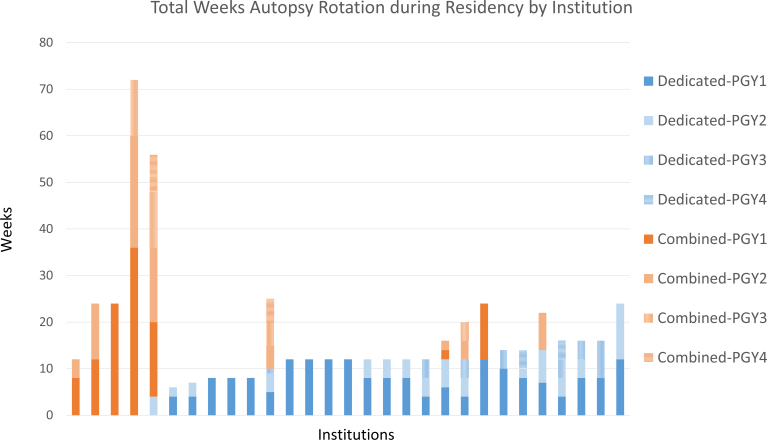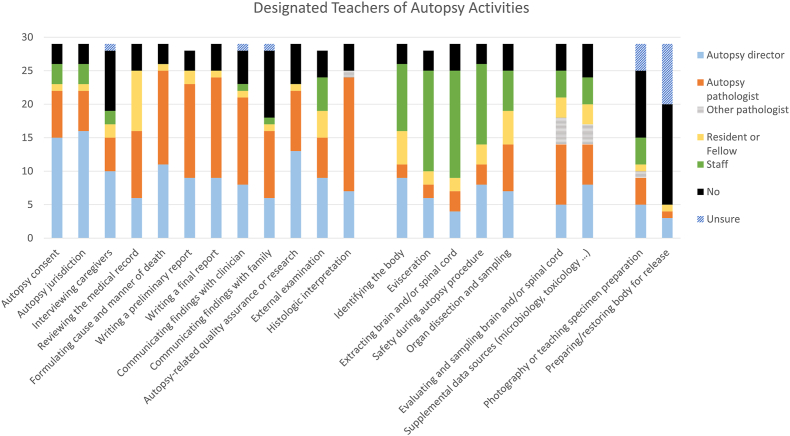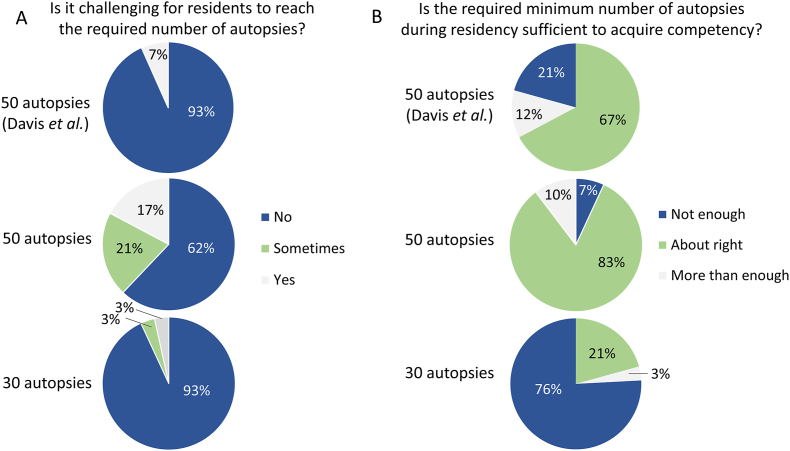Challenges in autopsy training for pathology residents: A survey of autopsy directors
IF 1.3
Q3 PATHOLOGY
引用次数: 0
Abstract
Resident training in autopsy provides a foundation of knowledge and skills for forensic pathologists and anatomic pathologists, but obstacles are present in ensuring quality training. A survey of US autopsy service directors at sites with pathology residency programs was used to identify common challenges in resident autopsy training. Respondents (n = 29) largely believed that negative attitudes from residents, faculty, training programs, and/or the medical system at large (34%) and time limitations (34%) were the most significant challenges for residency autopsy training. Regarding the Accreditation Council for Graduate Medical Education's decreased autopsy requirements from 50 to 30 required cases, respondents noted decreased difficulty (38% to 7%) for residents to achieve the minimum of cases but increased concerns regarding competency at this minimum (7% to 76%). Other impacts of this reduced requirement included decreased interest from residents after meeting minimum requirements, shortened autopsy rotations, increased resident-free autopsies, and increased use of pathologist assistants. Two programs (7%) described a decreased need for residents to share cases, but no other potential benefit was described. In addition to the value provided to the community through autopsies, autopsy training during residency provides knowledge and skills relevant to anatomic pathologists generally and forms a necessary foundation on which forensic pathology fellows and future autopsy attendings can develop proficiency. Continued effort is needed to promote the importance of autopsies to pathology residents and others and to provide sufficient training to produce pathologists competent in autopsy pathology.



病理学住院医师解剖训练的挑战:解剖主任的调查。
尸检住院医师培训为法医病理学家和解剖病理学家提供了知识和技能的基础,但在确保培训质量方面存在障碍。一项对美国尸检服务主任的调查,在有病理学住院医师项目的地方被用来确定住院医师尸检培训的共同挑战。受访者(n = 29)大多认为来自住院医师、教师、培训计划和/或整个医疗系统的负面态度(34%)和时间限制(34%)是住院医师尸检培训面临的最大挑战。关于研究生医学教育认证委员会将尸检要求从50例减少到30例,受访者指出,住院医生达到最低病例数的难度降低了(38%至7%),但对最低病例数能力的担忧增加了(7%至76%)。这一要求降低的其他影响包括:满足最低要求后,住院医生的兴趣降低,尸检轮询时间缩短,住院医生无需尸检增加,以及病理学助理的使用增加。两个项目(7%)描述了住院医生分享病例的需求减少,但没有描述其他潜在的好处。除了通过尸检为社区提供的价值外,住院医师期间的尸检培训还为解剖病理学家提供了相关的知识和技能,并为法医病理学研究员和未来的尸检主治医师发展熟练程度奠定了必要的基础。需要继续努力向病理学住院医师和其他人宣传尸检的重要性,并提供足够的培训,以培养能够胜任尸检病理学的病理学家。
本文章由计算机程序翻译,如有差异,请以英文原文为准。
求助全文
约1分钟内获得全文
求助全文
来源期刊

Academic Pathology
PATHOLOGY-
CiteScore
2.20
自引率
20.00%
发文量
46
审稿时长
15 weeks
期刊介绍:
Academic Pathology is an open access journal sponsored by the Association of Pathology Chairs, established to give voice to the innovations in leadership and management of academic departments of Pathology. These innovations may have impact across the breadth of pathology and laboratory medicine practice. Academic Pathology addresses methods for improving patient care (clinical informatics, genomic testing and data management, lab automation, electronic health record integration, and annotate biorepositories); best practices in inter-professional clinical partnerships; innovative pedagogical approaches to medical education and educational program evaluation in pathology; models for training academic pathologists and advancing academic career development; administrative and organizational models supporting the discipline; and leadership development in academic medical centers, health systems, and other relevant venues. Intended authorship and audiences for Academic Pathology are international and reach beyond academic pathology itself, including but not limited to healthcare providers, educators, researchers, and policy-makers.
 求助内容:
求助内容: 应助结果提醒方式:
应助结果提醒方式:


